I stuck to my guns and did not give into Pier pressure this year. I had been adamant after last year that I would not go to Armory shows at the piers again. I had gone for about 8 years, and in the mid-2000s I could funnel and process boredom into research for my essays “Trite Tropes, Clichés, and the Persistence of Styles” and “Recipe Art.” But each of the past three years I would resolve never to go again, because basically it’s out of the way, tiring, and even if you see a few good artworks and run into a few friends, and are seen being part of the artworld in some capacity, if only physical presence, by the time you struggle to re-find the city, via taxi or some of the longest walks to public transportation ever or the little jitney buses to civilization, if you are lucky, you can’t remember a thing. Only your camera remains a record of ever having been there and the sameness of my photo folders from year to year was grating on me. But each year I got drawn back because a group of friends would say, let’s meet, and then you think, well, OK, must see to talk to students about, don’t want to be left out, or don’t want to forgo pleasure of hanging out with friends. I almost got sucked in by that mechanism again this year, but finally I managed to hold tight.
I had not been to Chelsea for several very busy weeks, and shows were piling up that I wanted to see. My compromise with Art Fair culture was to go to the Independent because it was in Chelsea and then see a few shows. It was a beautiful spring-like day which, following upon a grey wintry snowy slushy day, gave me a boost of optimism and my choice of action left me with enough energy to cap the day by going to the ADAA Art Show at the Park Avenue Armory.
Briefly: both of these Fairs seemed disappointing, with a mix of vulgarity on the one hand, and vacant genericity on the other–works that would look tacky in a Nike shop and works that would look blamelessly attractive in a corporate boardroom, this pertaining in particular to the works exhibited at the Independent, with the Park Avenue Armory presenting more blue chip works that had a different kind of blandness with a few really pieces in the mix in a less circus- like and calmer atmosphere. But in each fair, one art work or series of works by one artist stood out and redeemed the whole exercise. As my mother said, on our way home from the last museum exhibition she saw–a 2006 exhibition at the Whitney Museum of the influence of Picasso on American art–it makes you want to go home and make art–she was then 95 years old and could barely stand up at the show and she still felt that inspiration. That is what I look for, that is why I started this blog, to record those moments, when amidst all the dross and worse that forms part of any decade of negative thinking, an artwork cuts through the crap and makes me want to turn on my heels, cover my eyes as I rush out of the building, and try to get home with that sense of inspiration and renewed energy to make art intact.
At the Independent, I came up first to two small grey works hung on a wall.
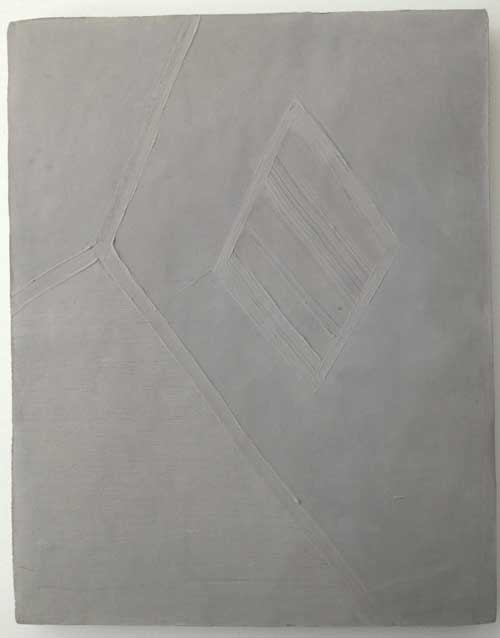
Were they paintings? There was the trace of what might appear to be a raised brushstroke on one, but then I realized that this was not a painting but a clay tablet, of a restrained abstraction in a modernist vein. Many more such tablets were arrayed on four sun-raked tables, lying flat, as much sculpture, installation, and display in the archaeological section of a museum, like cuneiform tablets from ancient Babylonia, or like books presented in a museum setting, with their covers closed, presenting a nearly inscrutable face. Most of the tablets were gray clay, one was the color of yellowish wax. A few were completely plain, blank slates, others had geometric forms cut into them or as raised forms upon them, one had a small face peeking out of a small fold or slit in the clay field.

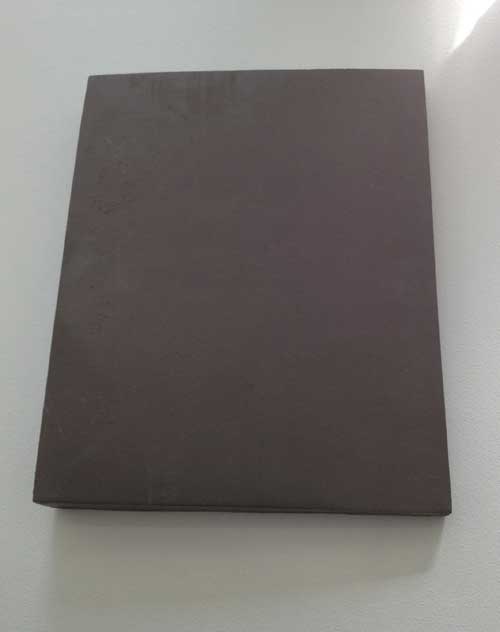

The works’ use of geometry and other aspects of painterly and well as sculptural abstraction refreshed the possibilities of abstraction developed in the modernist period. The work asserted that one can use a circle or a triangle or a line on an “empty” field and make it have the same interest of a genuine search for form and a belief in formal and composition aesthetic categories as artists from the modernist movement and make it seem newly experienced.
These works exemplified my ideas about modesty as a qualify in art that is not limited to small scale but that engages formal and intellectual rigor and ambition for the art work, rather than punching you in the face with the artist’s ego.
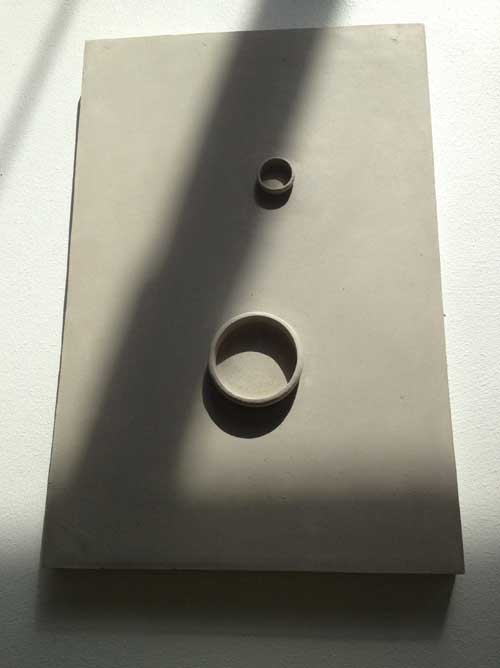
This is work by Anna-Bella Papp, a young Eastern European artist and I can only hope that the visual clarity, intelligence and dignity of these works is something that the artist can hold on to and grow, rather than devolving into production if her works encounters material success.
Last year, the Park Avenue Armory exhibition of the ADAA was a relief from the Piers, quieter, more sedate, with greater emphasis on the modern than the contemporary. It was possible to see some art, and that was a gift, so I went back this year. The atmosphere remained more civilized, less like the midway of a county fair, but perhaps familiarity led to feeling a bit less inspired, until on my way out, I passed the booth for Galerie St. Etienne. I stopped, thinking, oh, they may have something worth seeing..and turning a corner into a small enclosure I found myself in front of a small yet vital masterpiece, Egon Schiele‘s watercolor Newborn Baby from 1910.
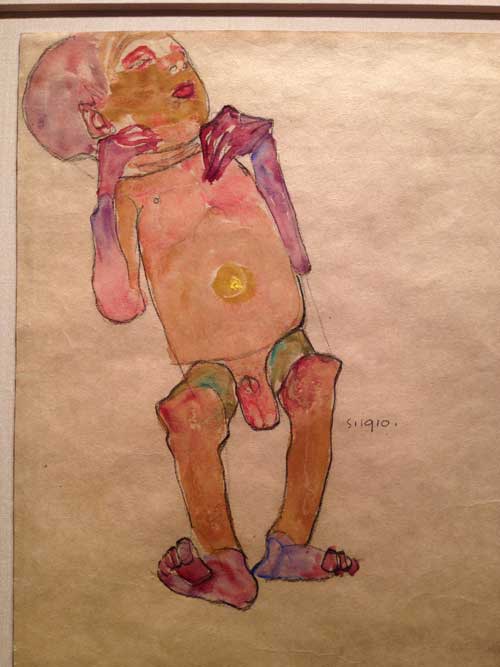
Egon Schiele, Newborn Baby, 1910. Watercolor and pencil on tan wove paper. Galerie St. Etienne
I suspect that many people value Schiele more for the sexual angst expressed in the synergy between his subjects and his style, than for his aesthetic decisions. This work’s intimate, pitiless yet deeply humanistic focus on a newborn baby, body akimbo and marked by the disproportionality of the neonatal, painted in the vivid colors of birth, pink, purple, and red washes and and impasto yellow belly button marking the last moment of total physical connection to the mother’s body, is another way of considering both Schiele’s artistry and his deep sympathy with the vulnerability and strangeness of human embodiment.
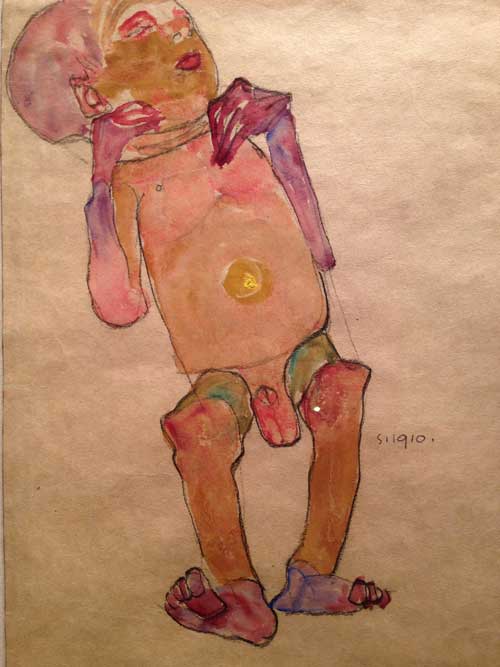
These two valuable experiences with art were worth more than acres of the Piers, and though I can’t say I was able to go home and make art, I left while I was ahead and with these experiences stored in my mind for future support and encouragement.
